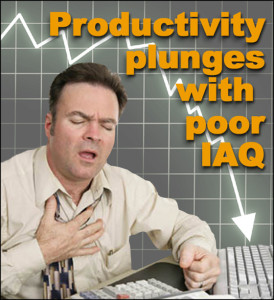Healthy Workers Are Productive Workers
The Environmental Protection Agency (EPA) believes as many as 30% of new or renovated structures have serious building indoor air quality issues. That is an alarming statistic, since Americans spend 90% of their lives indoors.
Indoor air quality can actually be many times worse than outdoor air on a smoggy day.
 Literally thousands of pollutants found in poor building air quality are known to impact health. Indoor pollution may negatively affect vision, hearing, growth, intelligence, learning, respiration, and heart function. Some pollutants are also carcinogenic.
Literally thousands of pollutants found in poor building air quality are known to impact health. Indoor pollution may negatively affect vision, hearing, growth, intelligence, learning, respiration, and heart function. Some pollutants are also carcinogenic.
The High Cost of Poor IAQ
Compromised indoor air quality (IAQ) costs American businesses an estimated $300 billion a year in lost productivity and profits.
Poor IAQ racks up $30 billion every year in health care costs alone. The Occupational Safety and Health Administration (OSHA) places a $15 billion annual price tag on sick leave paid to workers suffering from bad building air quality.
Studies have found utilizing ways to improve air quality boosts employee productivity by 6%-10%!
Lost revenues and productivity are just part of the picture. Contaminated indoor air quality may bring lawsuits, compensation claims, and damage claims against a business, further eroding the bottom line.
Be Proactive: Enhance IAQ in Business
The best defense against poor building air quality is offense. Consider these ways improve air quality:
- Have a plan in place for evaluating any IAQ complaints along with ways to improve air quality.
- If leasing, be sure your lease contains clear-cut IAQ guidelines. Notify building management immediately when building air quality issues arise.
- Choose “green label” products with low volatile organic compounds (VOC) emissions for all building, remodeling, or renovating.
- Use exhaust fans to disperse contaminants at the source.
- Keep the temperature and humidity levels comfortable.
- Keep all surfaces and HVAC systems clean. Change HVAC filters regularly. Use high-performance filters.
- Keep chemicals to a minimum. Use healthier, non-toxic cleaning products. Choose non-chemical solutions for pest control.
- Do not procrastinate. Attack building air quality problems immediately and search out ways to improve air quality.
Cleaner Air Improves the Bottom Line
It costs very little more to build and operate a healthy building environment. With energy efficient features, it often costs less to operate a health-promoting structure.
Maintaining a contaminant-free workplace provides many benefits, including:
• Improved productivity.
• Happier, healthier employees.
• Greater job satisfaction.
• Less complaints.
• Less absenteeism.
• Less turnover.
• Increased profits.
• Increased value for the building.
Choose Integrated, Whole-Building Systems
Inorganic, pre-engineered steel building systems like RHINO’s eliminate many of the indoor air quality problems associated with traditional construction materials.
Our structures produce a tight fitting building envelope, reducing outdoor contaminants from infiltrating the structure. Rigid-frame steel buildings repel termites and pests, terminating the need for chemical termite treatments.
Steel does not mold. As an inorganic material, steel does not release VOCs, and is one of the efficient ways to improve air quality of a building during construction.
When combined with the RHINO Pro-Value insulation system, our steel buildings save up to 50% on energy usage. The ultra-thick Pro-Value insulation significantly reduces outside noise pollution from entering the structure— another health benefit.
Start with a building system and a company you can trust. Call RHINO right now for a free quote on your next building project. Our is 940.383.9566.
